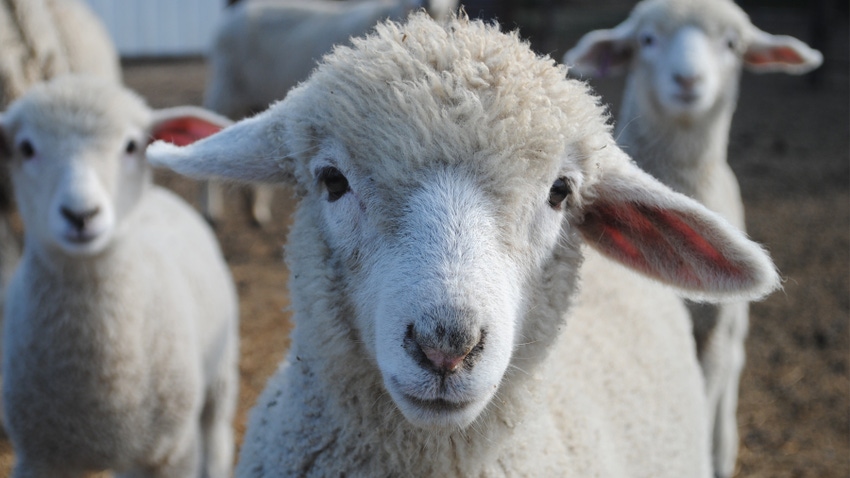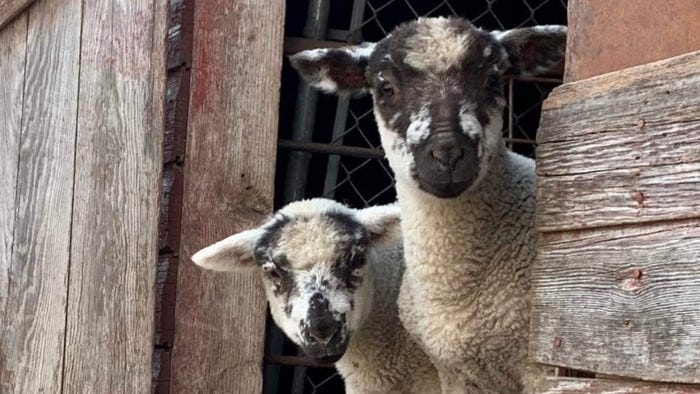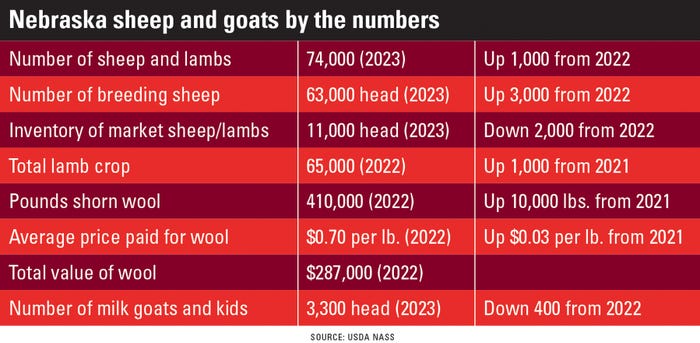May 23, 2023

by Holly Wortmann
Sheep and goats in Nebraska may be the less-talked-about ruminants, but many Nebraskans are finding they are versatile livestock. They hold solid inventory numbers, can complement a beef operation, and there is an uptick in interest among youth and livestock producers in the state.
Dan Stehlik grew up raising sheep on his family’s farm near Dorchester, Neb., and he is president of the Nebraska Sheep and Goat Producers Association (NSGPA).
“Today’s small ruminant production has the possibility to be a huge component toward rural economic development,” Stehlik says. “The umbrella of related businesses with sheep and goat production is broad, and creates unique opportunities for those promoting meat, wool or milk from these animals.”
Starting small
For someone interested in entering small ruminant production, Stehlik advises to start small and get experience to minimize risks. Herd numbers can grow quickly as management is established.
“In 1975, I graduated from University of Nebraska School of Technical Agriculture in Curtis and intended to raise pigs,” Stehlik says. “I gave that up in the mid- ‘90s and moved to Kansas to teach high school agriculture. In 1999, I purchased three cull ewes and used the lambs to start FFA and 4-H projects for my students. Under guidance from my brother, Eric, this grew to 100 head of ewes in 10 years.”
In 2015, Stehlik assumed a mechanics teaching position with Nebraska College of Technical Agriculture and moved his flock to Curtis. He is working with NCTA livestock instructor Kelley Duggan to develop a small ruminant course for 2024.
Stehlik says to expect occasional setbacks as your program becomes established. “Keep records and work with your veterinarian. Find a mentor for guidance, suggestions and sometimes encouragement,” Stehlik recommends. “NSGPA’s biggest organizational thrust has been to assist producers to be successful. Topics presented at conferences about nutrition, newborn care, equipment and facilities, predator solutions, and health management are intended to provide producers with information they may need. As success builds and small ruminant numbers increase, we can develop resource availability. These resources might include types of feed, veterinarian services, equipment products, increased markets, small ruminant research and more.”

PERFECT FOR YOUTH: NSPGA president Dan Stehlik says that sheep and goats offer a perfect youth 4-H or FFA enterprise.
NSGPA has more than 50 members statewide and dovetails with other groups to promote the sheep and goat industry. One major consumer-awareness event the group hosts is meat sampling at the Nebraska State Fair.
“Folks are generally surprised at how good lamb or goat can taste and how healthy the product can be,” Stehlik says. “We provide recipes and possible in-state sources to purchase products for their own consumption. Lamb and goat is a good source of protein.”
Expanding markets
Nebraska’s consistent sheep and goat inventory numbers from USDA’s National Agricultural Statistics Service are due, in part, to ethnic market growth, with immigrants often coming from lamb- or goat-eating parts of the world.
Stehlik says that Nebraska producers should look for ethnic opportunities for additional sales in products. “Consider ways to expand sheep sales by spring and fall lambing through accelerated programs or by having two separate seasonal flocks,” he says. “Multi-seasonal wool breeds and hair sheep are becoming more popular and tend to breed more consistently outside of the traditional season.”
To continue market growth, Nebraskans will need to rely on the next generation of producers. Stehlik says that lambs and goats are great starter projects for young people in 4-H and FFA.
“Lambs or kids provide several advantages over beef, dairy or swine projects,” he says. “They are generally considered safer because of size; lambs and kids are easier to handle. They do not kick, bite, run off or charge. There is less cost to buy the animal, thus less risk if something goes wrong.”
“Because they are smaller, the amount and cost of feed is considerably less than other projects. Typically, seven sheep equate to one beef animal. Sheep and goats usually produce less manure, and therefore, flies and odor are reduced compared to other species. Smaller or remodeled swine facilities can be used to house these animals.”

Between 4-H and FFA, Nebraska’s youth declared 1,077 sheep and 609 goats as eligible 2022 projects they would have wanted to exhibit at the Nebraska State Fair. In 4-H, youth can show based on breed type in both breeding sheep and breeding does, so this does allow a youth to begin their own breeding stock business.
To learn more about the industry, NSGPA is sponsoring a tasting event Aug. 27 at the Nebraska State Fair in Grand Island. The NSGPA annual conference and meeting is set for Sept. 9-10 in Broken Bow. The 4S Goat Expo and Sale is Sept. 23-24 in North Platte.
Learn more at nebraskasheepandgoat.org.
You May Also Like




